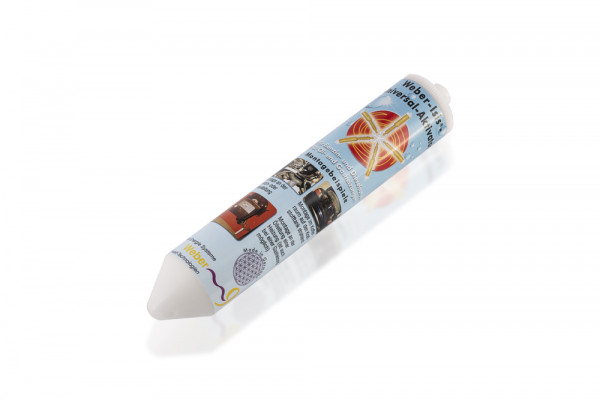For the energetic treatment of liquid media such as gasoline, diesel, heating oil, gas
Prices incl. VAT plus shipping costs
Ready to ship today,
Delivery time appr. 1-3 workdays
- Order number: SW10058
For less emissions and more well-being
The Weber-Isis®-Universal-Activator is suitable for liquid media such as petrol, diesel, heating oil, gas, etc. The Weber-Isis®-Universal-Activator is a bio-energy accumulator with positive vibration information, geometric shape radiation, copper spirals, various organic and inorganic material layers. It does not require any maintenance and does not need any power supply. The outer shell is made of food grade plastic (POM). Inside there is an Isis orgone emitter made of brass (bioenergy accumulator see fig. 1). The plastic casing must not be removed. This plastic is heat resistant up to 120°.
Best installation possibility:
If the Weber-Isis®-Universal Activator is to be attached to a line (e.g. gasoline), the tip should be attached radiating towards the fuel line. Fasten with wire or cable tie at the front and back so that no vibrations occur. (See Fig.2) This is the best method of installation.
Comparison Studies:
The universal activator was tested by a motor performance test. Furthermore, a comparative study was carried out by the Hagalis Institute of chemical and microscopic tests. Through these tests, it was made visible that reactions are likely to take place in the material, as well as in the ethereal realm.
Plant trials:
Experiments were undertaken with fumigation of two evenly vegetated greenhouses with the same plant population. Diesel fumes activated by the car via a hose were introduced into one of the two greenhouses, while the other greenhouse was fumigated with non-activated diesel fumes. This was done for half an hour every day for several weeks. The greenhouses were closed for the duration of the fumigation, after which they were ventilated again. At the end of the experiment, the greenhouse into which the non-activated exhaust gases were introduced showed almost complete destruction of the plants and fruit. In contrast, in the greenhouse into which the activated exhaust gases were introduced, the windows and plants were sooted, but the plants and their fruits were undamaged. Biological systems, such as plants, can probably tolerate treated exhaust gases better.
Other installation options:
For passenger cars, the Weber-Isis® Universal Activator is attached to a cable or steel spring in the trunk behind the trunk lid. It is attached through the hole at the rear end, with the tip pointing to the trunk floor above the fuel tank (see Fig. 3). Another possibility is to insert the Weber-Isis®-Universal Activator vertically, with the tip pointing to the floor of the vehicle, into the map shelf of the passenger door (e.g. wedge it between maps), because the fuel line runs at this point under the vehicle floor in most passenger cars. The Weber-Isis® Universal Activator can also be attached to the fuel filler neck inside the trunk. To do this, it is attached behind the interior trim with adhesive tape parallel to the filler neck with the tip pointing towards the bottom of the tank. Attachment to oil heaters and in the engine compartment of a car is accomplished by attaching the Weber-Isis® Universal Activator to the fuel supply line with the tip pointing to the line (see Figs. 2 and 5). The tip of the Universal Activator can also point directly at the carburetor, injection pump, or fuel filter, in which case it must also be attached on both sides to prevent vibration.
Side Effects:
Many users of the Universal Activator reported that electro-hypersensitive people could tolerate driving better after the Universal Activator was installed, and that the symptoms of electromagnetic stress experienced earlier could no longer be felt. Other users had problems with the negative vibrations emanating from the catalytic converter. After installing the Universal Activator, these individuals were also able to feel a positive change. Some users reported that they used to have problems with the transport of biological food and beverages, which were energetically discharged in the normal car, or had absorbed electromagnetic vibrations. These energetic burdens could also no longer be perceived by the said persons after installation of the Universal Activator. According to many customer reports, the Universal Activator can very probably have a positive effect on various systems of a vehicle.
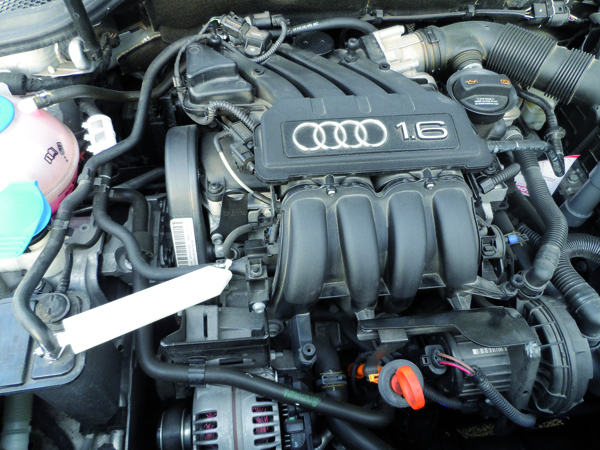
Fig. 2: Weber-Isis® Universal Activator installation in the engine compartment on the fuel line of an Audi A 3.
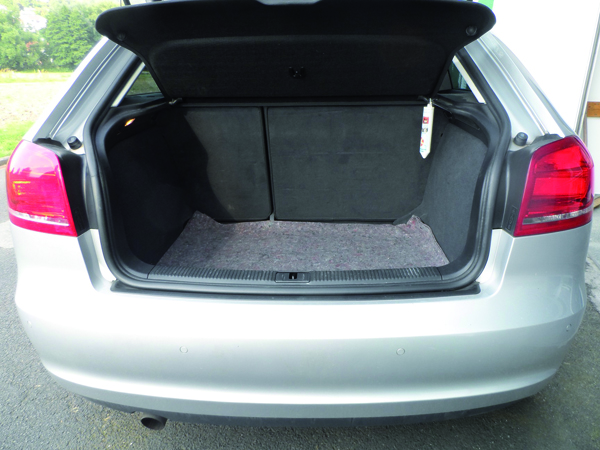
Fig. 3: Weber-Isis®-Universal-Activator installed in the trunk on the fuel tank filling side.
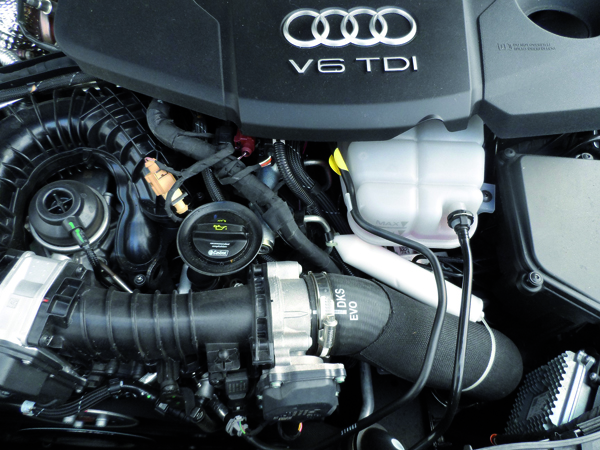
Fig. 4: Weber-Isis®-Universal-Activator installed in the engine compartment on the diesel line of an Audi A 6.
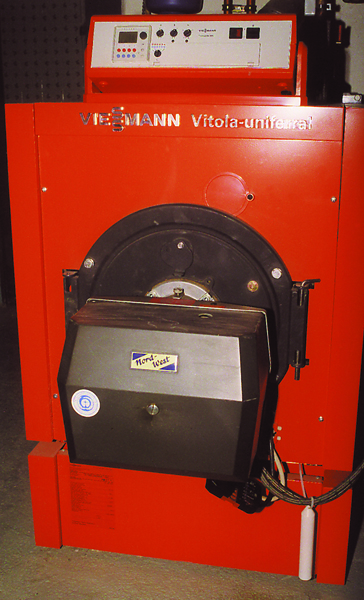
Fig. 5: Weber-Isis®-Universal-Activator: Installation at the heater in the basement (oil line)
Possible advantages
-
Better combustion is possible
-
Savings of up to 0.5-0.9 litres of fuel per 100 km as well as increased performance are possible.
-
Exhaust gas values can probably be improved.
-
In diesel vehicles, a black cloud of exhaust gas has not been detected either when stationary or while driving.
-
With older turbo diesel vehicles the loss hole can be bridged.
-
Higher engine speeds while driving can be achieved.
-
Electrosmog load in hypersensitive people can be better tolerated.
-
No more energetic discharge of biological food during transport in the car could be detected.
Test reports:
On the following pages we present some test reports from the Hagalis Institute, where two exhaust samples were examined. Once a neutral sample was examined, and as a second sample an exhaust sample treated with the universal activator. In the second evaluation "exhaust gas treated" one sees in the chemical evaluation, in the individual enlargements and in the summary, differences in comparison with the neutral sample. The exhaust gases could be improved in favour of the environment and the human being. The pollutant information can be decomposed more easily, moreover, a better combustion possibly took place. The better combustion may also have a beneficial effect on the gasoline or diesel consumption of a passenger car. A maximum saving of 0.9 litres of fuel per 100 km could be achieved in the test (with the same driving style as before the installation of the universal activator), but this cannot be guaranteed for every vehicle. Due to the improved combustion, no more black exhaust clouds could be observed in diesel vehicles, neither while stationary nor while driving. In addition, higher engine speeds can be achieved while driving. Many users report a noticeably better engine performance in the lower gears.
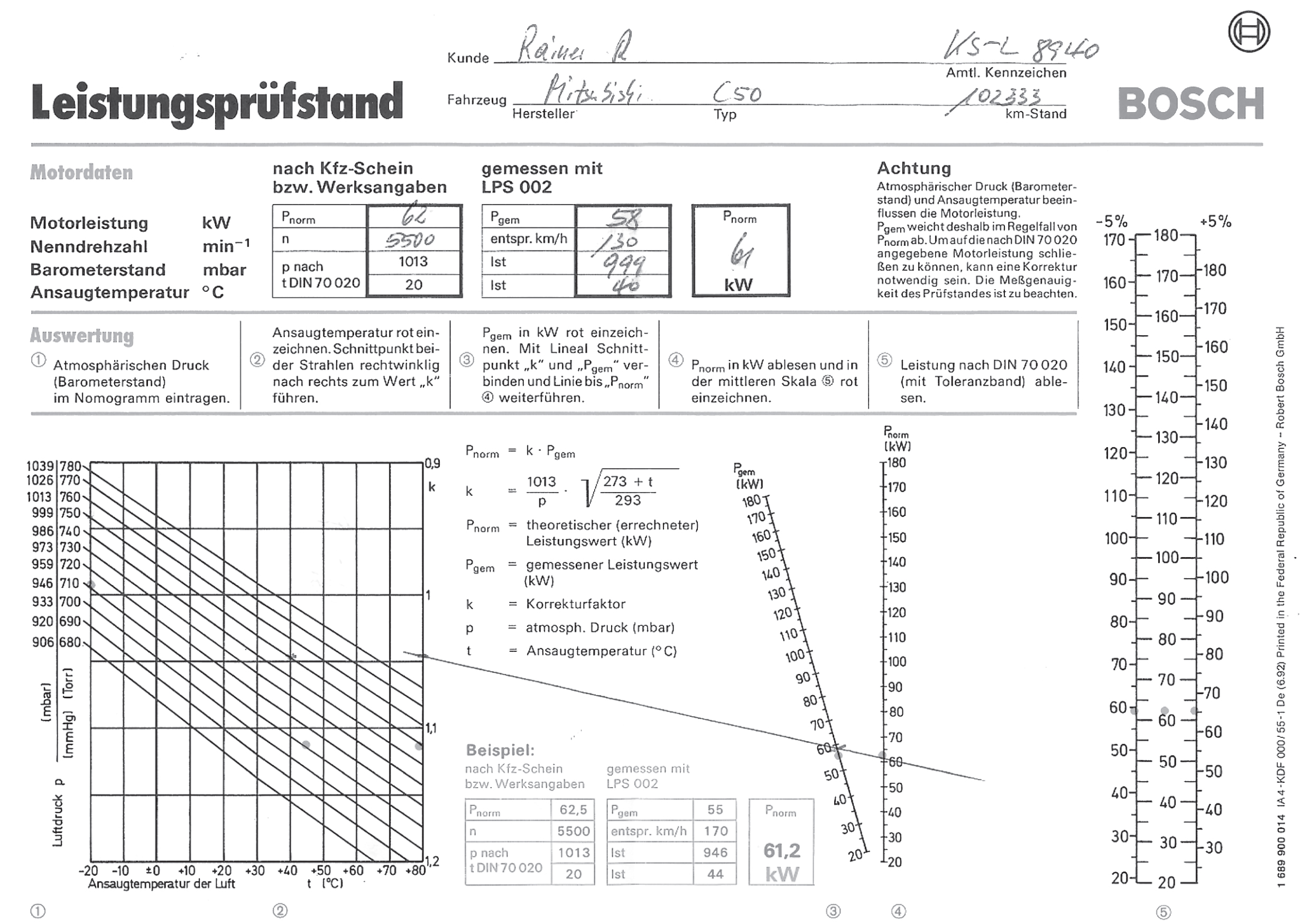
1. Engine performance test from 16.05.2001 without universal activator
Evaluation of the first performance test:
Furthermore, we performed an engine performance test with a Mitsubishi C50 passenger car (gasoline engine) to document the effectiveness of the universal activator. On the 1st diagram below you can see a performance curve with the values of the Mitsubishi without Universal Activator. Up to 50 km/h you can see a clear loss of power. According to factory data the car should have 62 kw engine power. On the dynamometer only 58 kw were measured, with a mileage of 102333 km, so a loss of 4 kw.
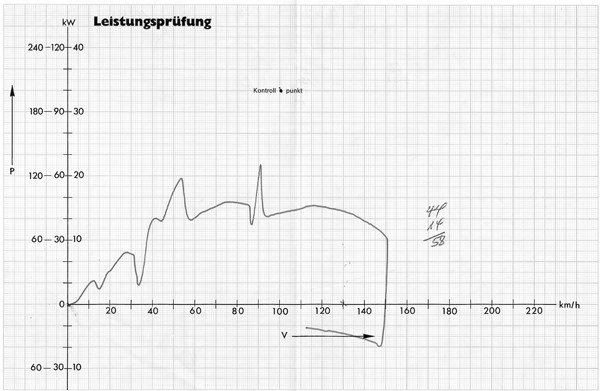
1. Engine performance test from 16.05.2001 without universal activator

Examined samples: Weber-Bio-Energy-Systems Water sample: Exhaust neutral
Within a comparative study, in which a total of 2 samples were taken, of which 2 came here for comparative evaluation, the spagyric crystallisate was examined, which was obtained from the liquid phase and the solid phase of the samples. The crystals are formed from the extraction of the distillate residue, which was previously ashed and calcined. These crystal salts are combined with the distillate and applied to slides. The liquid is allowed to evaporate at room temperature. During this process, crystal images typically associated with the samples are formed, which allow a statement to be made about the quality of the vital forces of the samples.
Production of the crystallisate at a glance:
1. Distillation of the sample without additions of water or other solvents at low temperatures.
2. Extraction of the crystal salt from the distillate residue by ashing and calcination.
3. Combination of distillate and crystal salts and subsequent application to slides.
- Formation of the typical crystal images associated with the samples -
The crystal images can be reproduced from the same sample at any time and always show the crystal images typically associated with the samples.
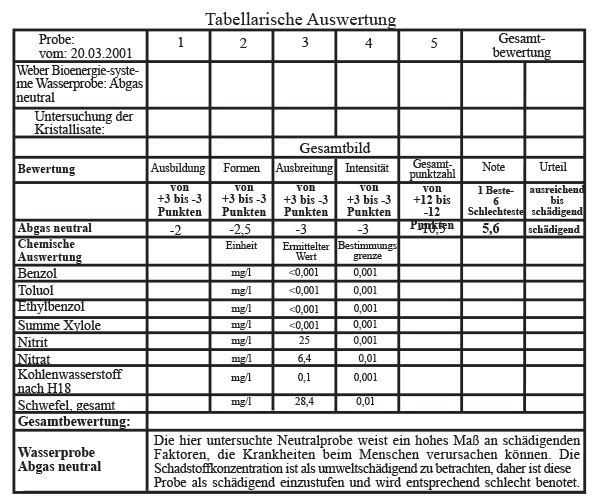
Weber-Bio-Energy-Systems water sample: waste gas neutral
The sample examined here represents the neutral sample in this test series, with which the following sample was to be compared with the system of the company Weber-Bio-Energy-Systems. In this test, exhaust gas from a Ford Sierra Combi Diesel car was introduced into water and then the concentration of pollutants was measured by means of the chemical parameters of sulphur, nitrogen oxides and hydrocarbons. At the same time, crystal analysis was carried out to determine the qualitative influence of the exhaust gas on the water sample. The neutral sample was taken one week before the treated sample, immediately after the sampling the car was treated with the system of the company Weber-Bio-Energetisierungssysteme and then left in the car according to an exposure time of one week. After that, the sample was taken again by introducing exhaust gas into the same amount of water. According to the same specifications, this sample was also examined with the same parameters. Both samples came here for comparative evaluation.
The neutral sample presented here shows clear concentrations of crystals in the peripheral area of the image, which indicate a pollutant load that has a harmful effect on the body system. These are hydrocarbons, which have a toxic effect on the human organism, where various diseases can be caused. However, this effect is relatively low in the sample examined here, in contrast to previous series of examinations, in which a much stronger toxic effect was perceived. Therefore, it can be assumed that the car used here already has a relatively clean combustion. In addition to the evaluations of the crystal analysis that have been carried out, the following peculiarities can be seen in the chemical parameters: The sulfur and nitrite values are similar to the hydrocarbon and nitrate values in the upper limit range of generally common exhaust gas values. As the Ford Sierra Combi Diesel car is an older model, this sample cannot be compared with values from very modern diesel vehicles, as these already have much better combustion technology. The values are in a concentration that is harmful to human health.
This is largely in line with the results of the crystal analysis, which also revealed relatively few but nevertheless very harmful toxins that are dangerous to the human organism even in low concentrations. This is expressed above all in the fact that the crystals are very closed in themselves, have linear structures and partly also form 90° angles. At the same time, there are a lot of crystal-free zones, which indicate a strong lack of vitality and bioactivity in the water. In this respect the waste gas has a damaging effect on the water.
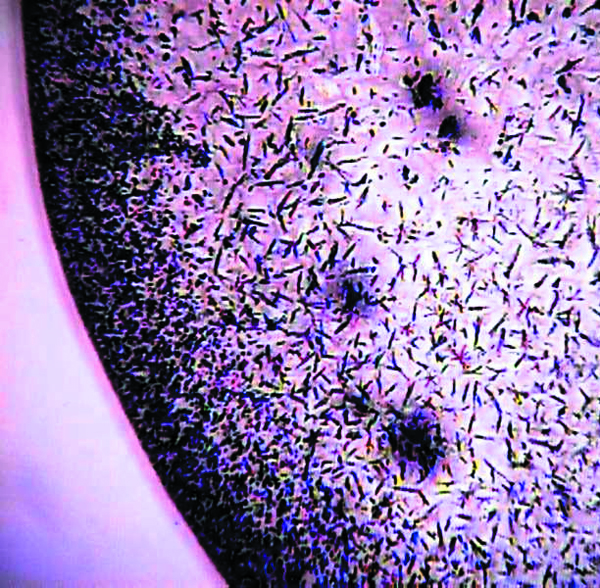
1. Full image: 40 - fold magnification, Sample: Weber-Bio-Energie-Systeme Water sample: waste gas neutral
The full image shows condensed crystal structures with dark zones at the edges. They indicate a toxic load and in particular the isolated crystallization here indicates a toxic load of the water sample, which is not present in the water sample without waste gas treatment. The discharged exhaust gas has thus clearly changed the water quality for the worse and shows here a harmful effect for the human organism. Although the indications of a harmful effect are not as strong as in previous test series, but since only small amounts of such toxins are necessary to cause harmful effects, this is reason enough to classify the sample as harmful. Nevertheless, the exhaust from this car appears to be relatively cleaner than that from other previously studied models. The full image does not show any clear 90° angular structures that would indicate further damaging factors, but these are only visible at 400x magnification and are described further there.
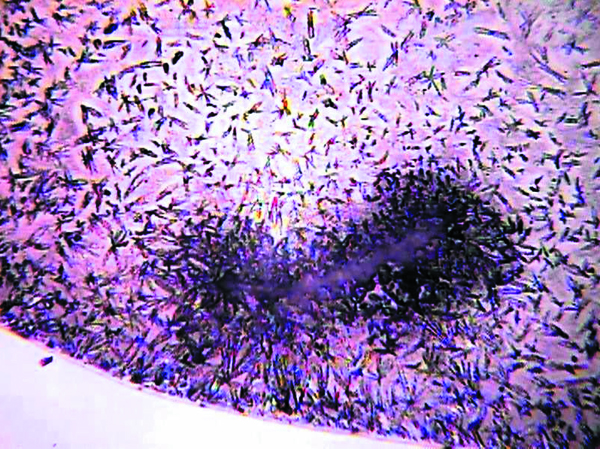
2. Half image: 100 - fold magnification, Sample: Weber-Bio-Energy-Systems Water sample: Exhaust gas neutral
In the half-image, the condensed crystal structures are even more clearly visible than at 100x magnification. Dark zones can be seen at the edges, indicating toxic substances. These are not soot particles, since they are removed beforehand during crystallization. Nevertheless, pollutant information, sulphur components and partly also heavy metals are present here, which can have a damaging effect on the physical system of humans. In this case, there is a clear concentration in the peripheral area corresponding to the effectiveness on the physical system. This means that, in contrast to other test series, a relatively clean combustion has taken place in the engine. Small linear structures indicate that there is also a damaging effect on the human physical system.
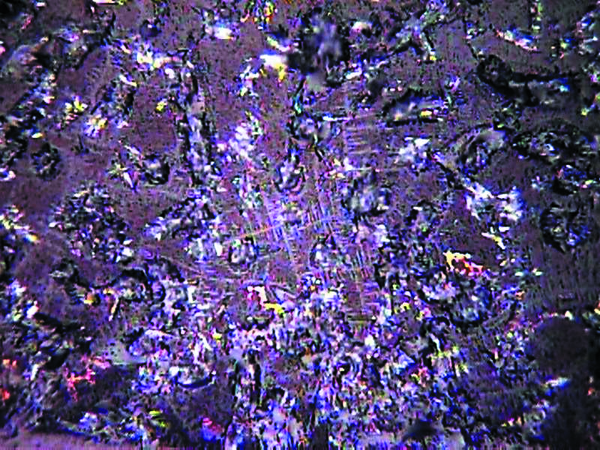
3. Large image: 400 - fold magnification, Sample: Weber-Bio-Energy-Systems, Water sample: Exhaust gas neutral
The large image shows chaotic structures of condensed crystal complexes, which are interspersed with finely formed crystals bearing a 90° angle structure. Here the damaging effect is particularly evident and in contrast to substances that can cause illness in specific organs. There is therefore an increased risk of falling ill if one comes into permanent contact with the substance. This is certainly a very negative characteristic of the sample examined here, which is why it is classified as very harmful to humans. In contrast to the water sample without exhaust gas treatment, such harmful signs are increasingly visible and clearly entered the sample through the exhaust gas pipe. The quality level of the sample itself is correspondingly low, which at first glance does not look so bad at the 40x magnification level.
Summary:
Sample: weber bio-energy systems Water sample: exhaust gas neutral Image comparison with the neutral sample:
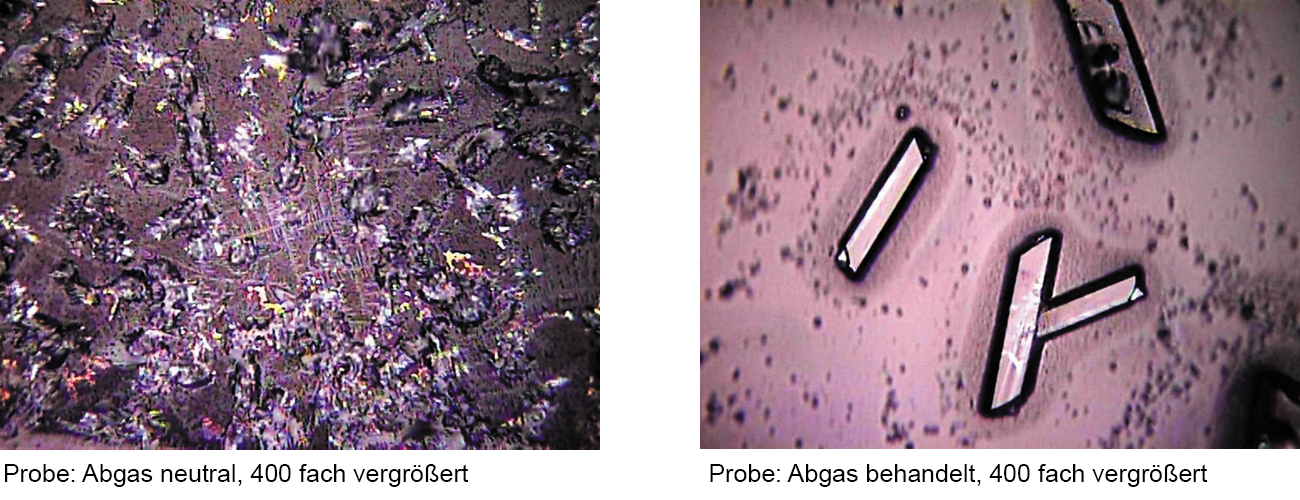
A direct comparison with the treated sample shows a clear difference to the disadvantage of the neutral sample. There are significantly more pollutants and more aggressive pollutant information here, which have a very damaging effect on the environment and humans, while the treated sample shows a significantly better result. Despite relatively good exhaust values of the neutral sample, very harmful elements for causing symptoms are present. The overall chemical values are clearly considered harmful. Therefore, the sample is classified as harmful to health. However, in order to deal with the medical effects and to be able to make more precise statements, further studies would have to be carried out in connection with blood crystal analyses. Unfortunately, this is not possible within the framework of this study.
Overall, we rate the system (without Weber-Isis® Universal Activator) as harmful and assign the grade 5.6 out of a total of 6 grades (1 = excellent; 6 = harmful). We thus indicate a harmful effect.
Aftholderberg, 12.04.2001
A. Schulz
(Examiner)

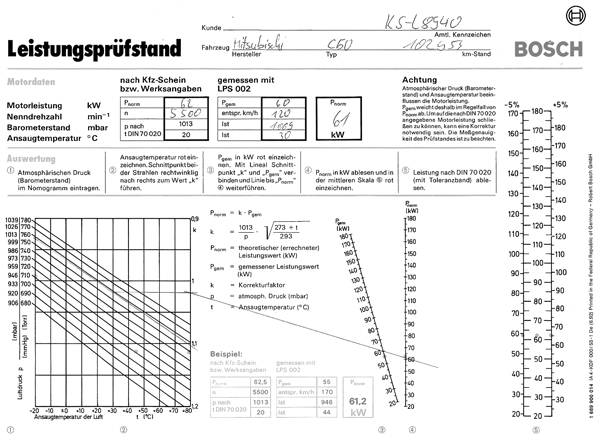
2. Engine performance test from 23.05.2001 with Universal Activator
Evaluation of the second performance test:
Before the second engine performance test (again the passenger car type Mitsubishi C50) a universal activator was installed at the fuel line and after 620 driven km (1 week later) another performance test was carried out. On the 2nd diagram you can see a clear change in the performance curve compared to the previous test. Up to 50 km/h a strongly rising curve is to be recognized, which lets conclude on a better acceleration, burn and pull-through achievement. (One can feel these before described results also in the subjective driving impression. Even people who did not know that a universal activator was installed in their car reported unanimously about a better performance of the vehicle). According to factory specifications the car should have 62 kw engine power, in the first engine power test only 58 kw were measured at a mileage of 102333 km. In the second engine performance test with universal activator 60 kw were reached at a mileage of 102953 km, i.e. an increase of 2 kw. It can be seen that the effectiveness of the Universal Activator can also be demonstrated using conventional methods. With engines of the newer generation with electronic control, these performance tests can no longer be carried out so successfully, because the control computer immediately adjusts changes back to the standard values.
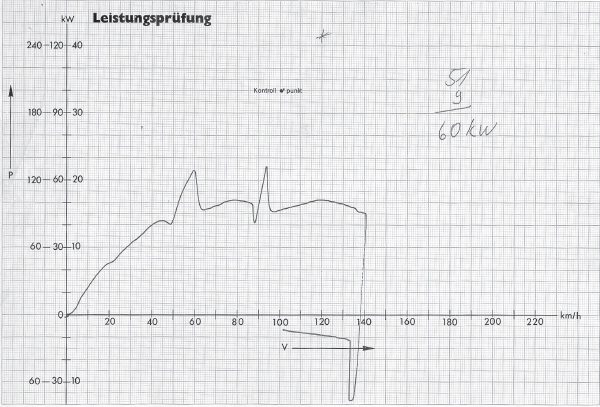
2. Engine performance test from 23.05.2001 with universal activator

Samples tested: Weber-Bio-Energy-Systems Water sample: Exhaust gas treated
Within a comparative study, in which altogether 2 samples were taken, of which 2 came here to the comparative evaluation, the spagyric crystallisate was examined, which was won from the liquid phase and the solid phase of the samples.
The crystals are formed from the extraction of the distillate residue, which was previously ashed and calcined. These crystal salts are combined with the distillate and applied to slides. The liquid is allowed to evaporate at room temperature. During this process, crystal images typically associated with the samples are formed, which allow a statement to be made about the quality of the vital forces of the samples.
Production of the crystallisate at a glance:
1. Distillation of the sample without additions of water or other solvents at low temperatures.
2. Extraction of the crystalline salt from the distillate residue by ashing and calcination.
3. Combining distillate and crystal salts and subsequent application to slides.
- Formation of the typical crystal images associated with the samples -
The crystal images can be reproduced from the same sample at any time and always show the crystal images typically associated with the samples.
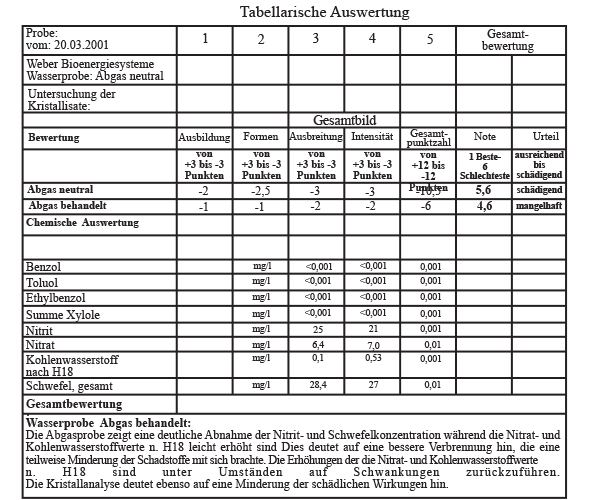
Weber Bio-Energy Systems Water sample: Waste gas treated
The sample examined here represents the treated sample with the system of the company Weber-Bio-Energy-Systems in this test series. In this test, exhaust gas from a Ford Sierra Combi Diesel car was introduced into water and then the concentration of pollutants was measured using the chemical parameters of sulfur, nitrogen oxides and hydrocarbons. At the same time, crystal analysis was carried out to determine the qualitative influence of the exhaust gas on the water sample. The neutral sample was taken one week before the treated sample, immediately after the sampling the car was treated with the system of the company Weber-Bio-Energetisierungssysteme and then left in the car according to an exposure time of one week. After that, the sample was taken again by introducing exhaust gas into the same amount of water. According to the same specifications, this sample was also examined with the same parameters. Both samples came here for comparative evaluation.
The sample examined here shows significantly less concentration of crystals in the edge region of the image. This indicates that the pollutant load, which has a damaging effect on the body system, has decreased somewhat. Although there are still signs of hydrocarbons that have a toxic effect on the human organism and can cause various diseases, the danger has become much less. In contrast to the previous sample, the car was clearly able to burn the fuel better, which was already well the case in the neutral sample, in contrast to previous series of tests, in which a significantly stronger toxic load was perceived. The treatment with the system of the company Weber-Bio-Energetisierungssysteme could reach therefore a quality revaluation of the water sample, rather reduce the pollutant load, which is expressed also with the chemical parameters.
In addition to the evaluations of the crystal analysis, the chemical parameters show the following peculiarities: The sulphur and nitrite values could be significantly reduced, which indicates a better combustion. The hydrocarbons and the nitrate value could not be reduced. If we look at the total nitrogen in the samples, the nitrogen rate could be reduced overall. Normally the nitrogen value is lowered especially at a lower combustion temperature. This can hardly be the case here, but it is nevertheless a clear indication of better combustion.
The results of the crystal analysis largely correspond to the results of the chemical analysis. Here, too, fewer pollutants are found than in the neutral sample, so that it can be assumed that the system was able to improve engine running. However, the most outstanding feature of the treatment with the system is the neutralization of the 90° angle structures, which could be seen in the neutral sample at 400x magnification. Thus the damaging effects have been neutralized to a large extent.Further details are described in connection with the pictures.
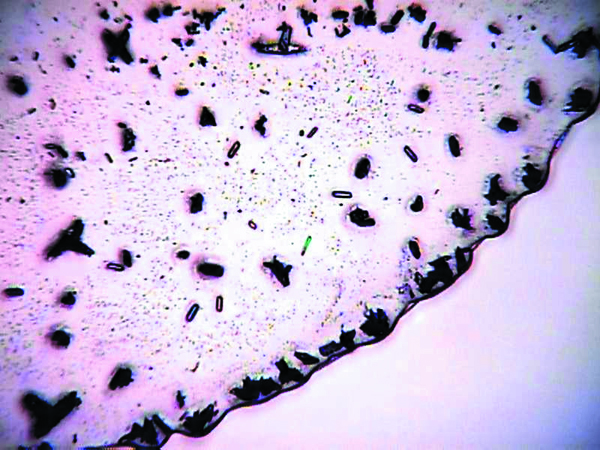
1. Full image: 40 - fold magnification, Sample: Weber Bio-Energie-Systeme Water sample: Exhaust gas treated
The full image shows much less condensed crystal structures at the edges. The dark zones have dissolved somewhat and show much smaller areas than in the neutral sample. The looser crystallization is a sign that the various damaging factors on the body system could be neutralized somewhat. At first the linear crystal structures look almost more harmful than in the neutral sample, but this impression is deceptive, since at the 400x magnification the structures are much less chaotic and more clearly formed, which will be described later in this picture. Although the discharged waste gas is still so damaging that it clearly changes the water quality for the worse and still shows a harmful effect on the human organism, the damaging effect could be clearly reduced compared to the neutral sample. In contrast to previous series of investigations, very good results are shown here, which could hardly be achieved so far. However, of course, no harmless quality could be established, as the remaining substances are still harmful to the human organism, although not to the catastrophic extent as with the neutral sample.
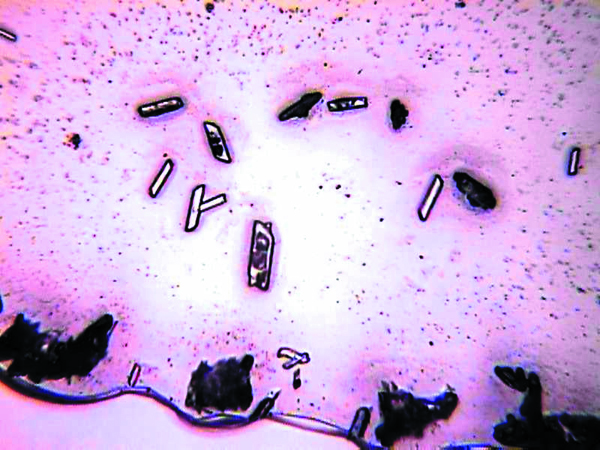
2. Half image: 100 - fold magnification, Sample: Weber Bio-Energie-Systeme Water sample: Exhaust gas treated
The half image shows less condensed crystal structures than the neutral sample. The dark zones at the edges indicate considerably fewer soot particles, sulphur components and heavy metals, which proves a clear qualitative improvement in the combustion of the engine. Therefore, the effects of the system of the company Weber-Bio-Energetisierungssysteme are clearly proven here. It is true that the harmful influences still have an effect on the body system. With regard to this phenomenon, no major change can be observed, which means that the metabolic activity of the water is still inhibited. The linear structures still occur and show a damaging effect on humans. However, due to the lack of the 90° angular structures, this effect is much less pronounced than in the neutral sample, so an ameliorating effect has also taken place here.
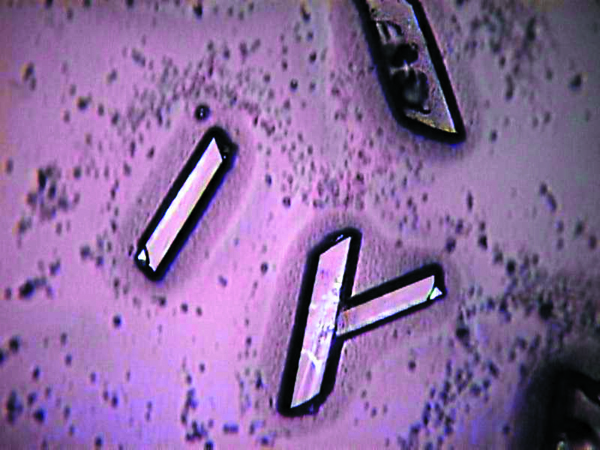
3. Large image: 400 - fold magnification, Sample: Weber-Bio-Energie-Systeme Water sample: Exhaust gas treated
Summary:
Sample: Weber-Bio-Energy-Systems Water sample: exhaust gas treated Image comparison with the neutral sample:

A direct comparison with the neutral sample shows a clear difference in favor of the treated sample. While no outstanding result can be determined in the 40x magnification, the changes in the finer crystal structures are shown to be outstanding. The harmful effect could clearly be improved in favour of the environment and humans, so that a better grade is quite justified. The chemical analysis also shows a reduction of the pollutants, whereby the crystal analysis shows that the pollutant information is less aggressive and thus more easily degradable than in the neutral sample. The chemical parameters also show reductions which indicate better combustion. In this respect, the system of the company Weber-Bio-Energetisierungssysteme has proven to be quite effective.
In order to be able to go into the medical effects and to make more precise statements, however, further studies would have to be carried out in connection with blood crystal analyses. Unfortunately, this is not possible within the framework of this study. Overall, we assess the test as sufficient to deficient and award the grade 4.6 out of a total of 6 grades (1 = excellent; 6 = harmful). (The grade refers to the water sample and not to the Weber-Isis® Universal Activator) Thus, we indicate a sufficient to deficient harmful effect for the water sample, but a good effectiveness with high efficiency for the system (Weber-Isis® Universal Activator) itself.
Aftholderberg, 12.04.2001
A. Schulz
(Investigator)

Further areas for the use of the Weber-Isis® Universal Activator
In these areas, as shown in the middle of the schematic diagram, the Weber-Isis® Universal Activator can bring about improvements in the subtle, etheric and material realms. To the positive advantage of humans, animals and the whole of nature. This is what I (Eckhard Weber) was concerned with when developing the Universal Activator: I wanted all plants, all trees as well as the whole of nature to be able to better break down the negative effects of the pollutants and pollutant information produced by combustion engines, and not to fall ill from them. The fuel savings that can also be achieved through this are only a positive side effect. This happens through the energetic effects of the Isis® orgone emitter in the Universal Activator on all fluid circuits of the car's combustion engine (fuels, engine and transmission oils, brake fluids, cooling circuits, etc.). However, I have been misunderstood by many customers in this regard. The focus of most customers was only on saving fuel, and that is what the Universal Activator was measured against. However, it was unfortunately mostly disregarded that I am primarily concerned with the positive improvement of exhaust gases in combustion engines, in the sense of relieving the burden on nature. Over the years it has made me very sad that I have not been properly understood here. For this reason, some time ago I had taken the Universal Activator off the market for some time. Through many positive encouragements from satisfied customers, I then further optimized the Universal Activator to the latest state of the art, made it available to everyone again, in addition with a newly designed and revised brochure. The cover of the brochure should already express what this device is capable of. The Universal Activator has been available on the market for over 20 years.
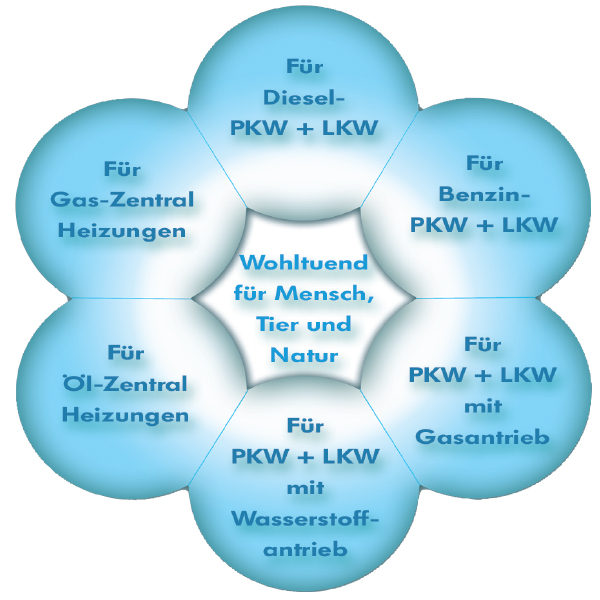
The Universal Activator is a very easy to install device. It can be attached very quickly to a car or truck and does not require an ABE (General Operating Permit), nor does it require a TÜV (Technical Inspection Agency) approval, as the device does not have a mechanical effect on the car, but only the fine-matter orgone energy. Also the guarantee achievements of the vehicle manufacturer remain in the full extent.
The device can be installed in the engine compartment in a very short time. It is attached to the petrol or diesel line. If you do not know exactly where this is located, you can also ask a master car mechanic in the workshop or have it installed by the car mechanic. The universal activator is then simply attached with two cable ties to the eyelets provided at the top and bottom directly on the fuel line, so that the universal activator is somewhat under tension and cannot wobble or vibrate in the engine compartment. The universal activator should be fixed in such a way that its tip points to the engine block or the injection pump if possible. This way the Universal Activator can develop its greatest potential. I would like to give you a small example of what this simple little device would be capable of if it were used throughout large metropolitan areas. Some time ago I was in Mexico City (about 9 to 10 million inhabitants). There is an abundance of exhaust smog there every day from cars and trucks, which has a very negative impact on people and the environment. During the time I was there, only cars with even numbers in the first digit of the license plate were allowed to drive; the following week, only cars with odd numbers in the first digit of the license plate were allowed to drive. This measure was an attempt to get the negative exhaust smog under control in order not to produce even more exhaust gases and thus environmental pollution. With the Weber-Isis® Universal Activator I can offer a solution to get this problem under control worldwide. We could solve these problems not only in Mexico City, but also in other big cities like Tokyo, New York, Beijing, Sao Paulo, and many more, if people would use and appreciate this very easy-to-use technology.
It will certainly take several decades until all cars and trucks worldwide would be equipped with electric motors (which would be almost impossible due to financial means in third world countries). Until there are electric cars all over the world, the Weber-Isis®-Universal-Activator would be a good and cheap alternative, a bridging technology with an efficient, positive benefit for humans, animals and nature, even for the whole planet earth. This would certainly also have a positive effect on the climate of the whole earth. My motto has always been, "When the need is greatest, so is the help!". Probably the need is not yet so great worldwide that such "alternative technologies" will be adopted.
Further installation possibilities on different types of vehicles
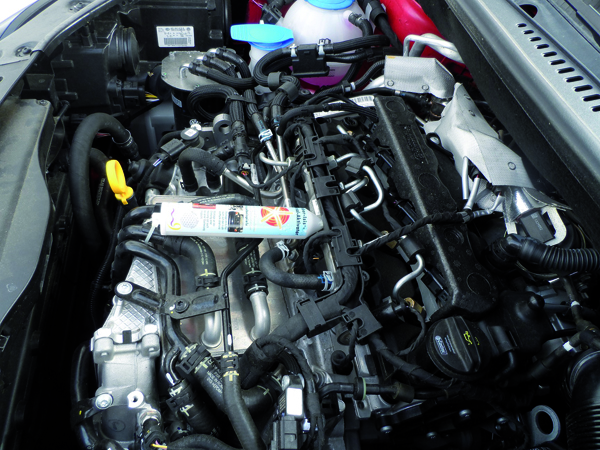
Weber-Isis®-Universal Activator Installation in the engine compartment on the diesel line of a VW Caddy.
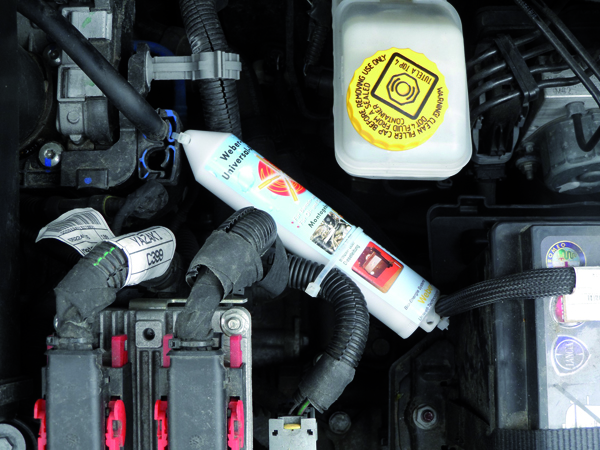
Weber-Isis®-Universal-Activator mounting in the engine compartment at the fuel line of a Fiat Punto.
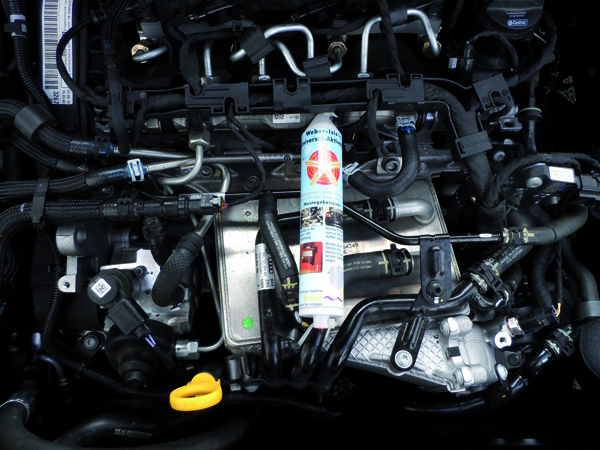
Weber-Isis®-Universal-Activator mounting in the engine compartment at the diesel line of a VW Caddy (other view).
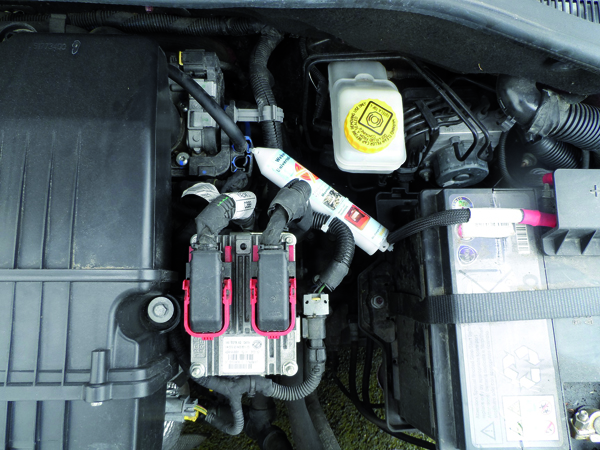
Weber-Isis®-Universal-Activator mounting in the engine compartment at the fuel line of a Fiat Punto (other view).

Cross-section drawing of the Weber-Isis®-Universal-Activator, Length: 18 cm, diameter: 35 mm, weight: 375 g
Please also note our information
Why we say so little about the effect of our products





